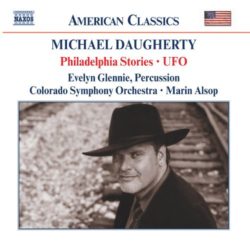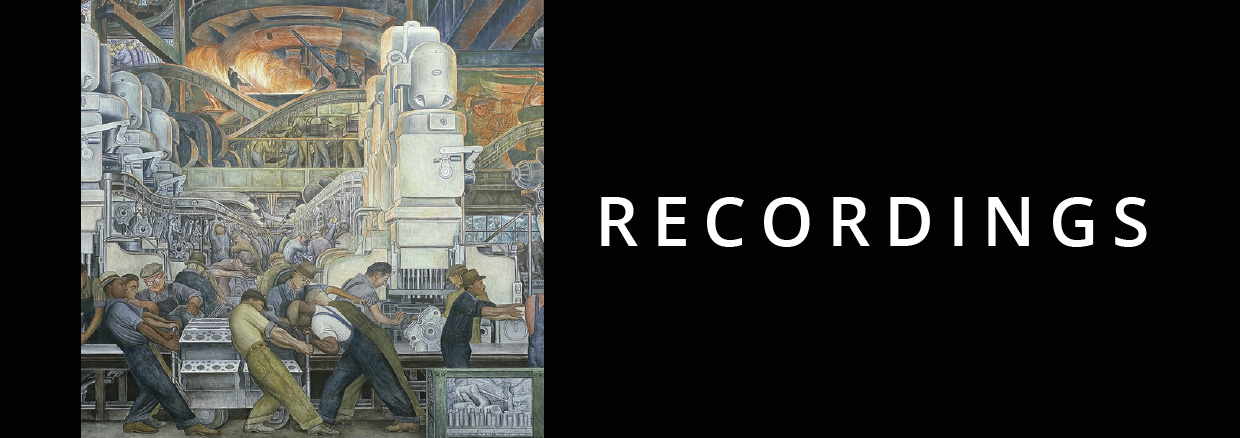Philadelphia Stories/UFO
Naxos/October 2004
Evelyn Glennie, percussion
Colorado Symphony Orchestra
Marin Alsop, conductor

REVIEW FROM CLASSICS TODAY:
Michael Daugherty gets a lot of attention these days because of his music’s reference to pop culture–and to the extent that he follows Dvorák’s dictum that there’s no inherent conflict between finding inspiration in the songs of “the people” and writing in large, classical forms, he’s on solid ground. I have enjoyed most of his works, especially the Metropolis Symphony (based on the Superman comics), though I felt his opera Jackie O left a lot to be desired. Here, however, we have two works that show him at his best, even if the mix of elements will be familiar to anyone who has heard previous discs devoted to his output.
Philadelphia Stories offers a characterful triptych of portraits, starting with an urban musical collage and proceeding to a luscious central interlude inspired by Edgar Allan Poe’s “The Tell-Tale Heart”. It ends with a riotous and wonderful tribute to Leopold Stokowski’s Philadelphia Orchestra golden age in the form of a massively entertaining, partly real/partly fake Baroque transcription with all of the bells and gongs that the Maestro loved so much. It’s an extremely well-written and clever piece, wonderfully played by Marin Alsop and the Colorado Symphony Orchestra. I don’t want to take anything away from their excellent effort by saying that I find it pathetic that the Philadelphia Orchestra itself, which seems to have the wherewithal to pay its players a base salary starting in the six figures, can’t bestir itself to record important commissioned works. On the other hand, if they want to marginalize themselves in favor of fine artists like Alsop and her Coloradoans, then so be it.
UFO is yet another percussion concerto inspired by the artistry of Evelyn Glennie, and it’s interesting to see how Daugherty uses the amusing premise to write “far out” music that otherwise might send conservative concert-goers screaming from the hall. Full of evocative, film score-ish sounds, this is actually the work’s second recording (an earlier version on Klavier features Glennie with the North Texas Wind Symphony). Daugherty is not, by the way, the first composer to have some fun with this theme: there is also a movement called “Flying Saucers” in English composer George Lloyd’s Charade Suite (available on Albany). In any event, the piece is great fun in both its tuneful and spacey passages, and it’s extremely inventive in its writing for the soloist. It goes without saying that Glennie is stupendous, though I find the recording places her too close and so tends to diminish the contribution of the orchestra. Still, this disc adds yet another highly enjoyable success to Naxos’ remarkable American Music series.
– David Hurwitz
REVIEW FROM CLASSICAL NET, 2012:
Michael Daugherty’s music confuses many who think about it. They tend to mistake him for a light, in the sense of minor or trivial, composer. By me, he’s an American poet, really no more light than Whitman or Ives. I admit his eccentricity. He combines within himself the hipster and the teen cruisin’ for burgers on a Saturday night. As a teen, he began playing in school marching bands and in rock bands. He played jazz professionally for a while. However, he also studied at North Texas (a cradle for avant-garde musicians) and Yale and in New York with serialist Charles Wuorinen, where he met Boulez. He spent some time at Boulez’s IRCAM (Institut de Recherche et Coordination Acoustique/Musique) in Paris, and produced music by Conlon Nancarrow and Gyögy Ligeti. He has serious avant-garde street cred. Why doesn’t he sound serious and Angst-ridden?
While knocking about Europe, he also studied with Ligeti, who encouraged him to incorporate American vernacular music, including jazz and rock, into his concert music. Most American composers with a pop background tend to keep it separate from Hochkultur. In short, Ligeti encouraged his student to get his entire self into music.
Daugherty took this to heart. He recognized the mutt culture of the U.S. and acknowledged the strength of his attraction to it. Part of an artist’s gift is noticing the extraordinary in the normal, effectively unnoticed thing. If the sight of a ’59 Caddy with tailfins does not excite you as much as a Brancusi, Daugherty may not be your composer. On the other hand, a musician of enormous cultural breadth works to adapt that culture to contemporary composition techniques. Daugherty also writes pieces inspired by Modern art.
Daugherty describes Philadelphia Stories as his third symphony. Its genre matters less than its music, of course, and he’s entitled to his wrong opinion. By me, this is no symphony, or even a cohesive composition, shown by the fact that the first movement, “Sundown on South Street,” and the last, “Bells for Stokowski,” are often programmed on their own. The score resembles more an Ivesian set, independent pieces tied together by an extramusical concept – in this case, Philadelphia. Daugherty seldom gives you classical forms. He seems happiest as a tone poet, and I think this gives audiences another in with the music. “Sundown on South Street” captures big-city energy, as Daugherty leads us on a tour along the street of the nighttime musical joints. A great variety of pop music styles passes before us. The slow movement, “The Tell-Tale Harp,” seems the weakest. It depicts the city once the sidewalks have been rolled up for the night. Edgar Allen Poe wrote his horror classic “The Tell-Tale Heart” in Philadelphia, although that’s a truly slender thread to tie this movement to the others. Daugherty’s movement features two harps, placed stereophonically on each side of the stage, spatial shaping of sound one of the composer’s favorite effects. It combines moods of walking through a graveyard, lush nocturne, and scherzo excitement (7/8 time). However, it doesn’t seem as sharply focused in conception as its companion movements. “Bells for Stokowski” meditates on the public career of conductor Leopold Stokowski, the creator of the Philadelphia Orchestra’s “Philadelphia sound.” We hear, among other things, Russian-like themes bringing to mind Stokowski’s treatment of composers like Rimsky-Korsakov and Mussorgsky, a passage reminiscent of the C-major prelude from Book I of Bach’s Well-Tempered Clavier, which brings to mind Stokowski’s classic, super-glam arrangements of Bach keyboard pieces, and moments of hard-edged Modernism, recalling Stokowski’s pioneering performances of then-Contemporary music like Schoenberg, Mahler, Stravinsky, Berg, Webern, and, later, Ives. Furthermore, Daugherty alters the orchestral sound in a way that suggests Stokowski’s experiments in orchestral seating, butt within the standard orchestral seating arrangement, accomplishing this by playing on ambiguous timbres of various instruments – violas sounding like violins and cellos, for example, or horn sounding like an oboe. At the finish, we hear organ-like buildups of sound, register upon register (Stokie began as an organist). A very evocative piece and, it turns out, a Daugherty “hit” on its own.
UFO, a virtuoso piece for percussion soloist and orchestra, explores the poetry of the tabloid staple of strange flying craft piloted by the green and be-tentacled. The conceit allows Daugherty to indulge in hardcore avant-garde timbral effects. Here, we see Daugherty’s Darmstadt background most in evidence. Five movements make up the work: “Traveling Music,” “Unidentified,” “Flying,” “???,” and “Objects.” It offers little narrative, and its two most common moods are the exhilaration of flying through the vastness of space and the strangeness of close encounters.
Evelyn Glennie gives a jaw-dropping performance in UFO. Her hands move quicker than the eye and almost the ear. However, she also can play very lyrically. Some of the effects Daugherty specifies can sound merely bizarre in other players. She makes them beautiful, without sacrificing their alien distance. Incidentally, her album photo makes her look a bit alien herself. She resembles a wild animal caught in a camera flash. This isn’t a nice thing to do to such a lovely woman. Marin Alsop “gets” Daugherty and the Romanticism hiding beneath his ironies and jokes. She keeps a convincing narrative going in “Bells for Stokowski,” which can sprawl and natter in other hands. The Colorado Symphony plays with conviction. I complain only about the recording of “Tell-Tale Harp,” where the stereophonic image insufficiently separates the two harps, which should be antipodal. Here, the first harp is clearly on audience left, while the second sounds somewhere to the near right of the conductor’s podium. Other than that, a fine disc.
– Steve Schwartz
REVIEW FROM CLASSICALCDREVIEW.COM, OCTOBER 2008:
The Naxos Michael Daugherty disk was issued about five years ago. Philadelphia Stories, commissioned by the Philadelphia Orchestra. was premiered with that orchestra conducted by David Zinman in November 2001. Daugherty calls it his third symphony, “a musical travelogue of the sounds of Philadelphia.” There are three sections, the first Sundown On South Street, the second Tell-Tale Harp, and the third, Bells for Stokowski, is a tribute to the conductor who led the orchestra from 1912-1936 and replicates sounds of the many bells of the city. This movement is particularly effective and was recorded earlier in an arrangement for winds with Jerry Junkin and the Dallas Winds, a fine recording in every way, but the music benefits from the sound of the full symphony orchestra. The many bells sound quite resplendent when surrounded by strings as they are on this recording. UFO was written for Evelyn Glennie on a commission from the National Symphony Orchestra. They gave the premiere in the Kennedy Center in 1999 with Leonard Slatkin conducting. The 36-minute score, inspired by unidentified flying objects and sounds, has five sections: Traveling Music, Unidentified, Flying, ???, and Objects. It is a brilliant showpiece for countless percussion instruments all spectacularly played by Glennie. Recently I saw her perform this work with the Baltimore Symphony under Marin Alsop’s direction. It was a wondrous event, both musically and visually. Glennie made her entrance in a darkened hall from the rear of the audience playing a “waterphone” which set an eerie mood that continued throughout. It was a virtuoso tour-de-force; and in the final section, Glennie played three different instruments at the same time. Let us hope eventually her amazing performance of this terrific score will be available on DVD. You can see her artistry on DVD now, performing Másson’s Concerto for Snare Drum and Orchestra, a Vivaldi concerto, and a group of pieces for marimba composed by Matthias Schmitt (see REVIEW). In the meantime, check out this splendid Naxos beautifully recorded disk. Highly recommended!
-Robert Benson
